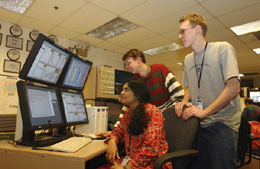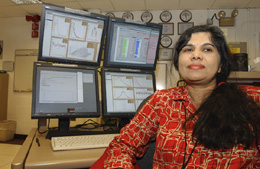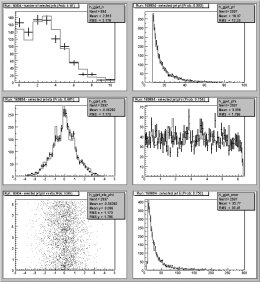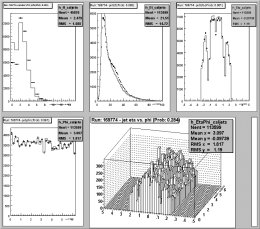 |
|
DZero Goes Global
by Mike Perricone On Friday, January 3 at about 5 a.m. Central Standard Time, Onne Peters was on a control room shift for Fermilab’s DZero detector when he saw something that wasn’t right: hot cells, or excess jets, appearing in the detector’s calorimeter. He immediately notified the shift captain, who alerted the calorimeter expert on shift, and the problem was solved.
It might sound like particle physics business as usual in the predawn of a winter morning, but there was a big difference: Peters was serving his DZero control room shift from a computer at NIKHEF, the National Institute for Nuclear Physics and High Energy Physics in Amsterdam, Holland. Some 4,000 miles and an ocean away from the chilly predawn in Batavia, Illinois, Peters was hooked into DZero’s new Global Monitoring System. DZero has seen the future, and it works. It works as far away as NIKHEF in Holland; the Saclay laboratory of CEA, the French Atomic Energy Commission; and the Tata Institute of Fundamental Research in Mumbai, India, where experimenters have taken “virtual” shifts in the DZero control room through the Global Monitoring System. “This is absolutely the wave of the future,” said Peters. “With increasingly international collaborations, it is just not feasible to expect people to be available on-site for a large amount of time. This is a trend we see with remote computing, the remote analysis stations, as well, and I certainly foresee that these projects will benefit high-energy physics greatly.” DZero cospokesperson John Womersley also sees future applications when the Large Hadron Collider begins operations at CERN, the European Particle Physics Laboratory. “Five to ten years from now, many U.S. institutions, Fermilab among them, will themselves become remote collaborators working on LHC experiments,” Womersley said. “We need to learn how to contribute effectively to all aspects of LHC physics, and remote participation in data taking operations will be an important piece of the puzzle. The global monitoring hookup was “godmothered” from concept to operation by DZero physicist Pushpalatha Bhat, with yeoman work on the user interface and the communication system—a global message board—by her undergraduate student, Jason Webb, who works part-time at DZero while studying electronic engineering at DeVry University in Addison, Illinois.
“It’s a joy to work with bright and motivated students,” Bhat said. “I love to encourage them to pursue studies in physics and perhaps a career in physics.” The project has had exactly that effect on Webb. “After working here at Fermilab,” he said, “I have been seriously considering going for a Master’s degree in Physics.” Bhat explained that the message board is used for chatting between people in the control room at the detector and remote shifters. Anyone else who wants to join and share information online can also communicate through the messenger system. A problem can be sent to this chat box, and it also appears on a web search board, where messages can be seen between the control room and the remote shifters. The messenger system also provides for archiving. “Sometimes, if I’m up late at night, I can go to the message board,” Bhat said. “Even if I do not log on to the detector’s online system, I can see what is being said back and forth, if there are any problems, or if there is anything that needs attention.” To be sure, as with any newly-developed (and developing) system, not everything goes smoothly. Sudeshna Banerjee of Tata Institute recalls a few weeks of “owl shifts” in Mumbai that pointed up some glitches. “Some days we had problems with communication because the message board got stuck frequently,” Banerjee said. “Therefore we did not do much ‘research.’ But maybe in the future things will get better.” Webb agreed that there is more work to be done on the messenger system. “I am working on making the messenger system more like ‘AOL Instant Messenger,’” he said. “I would like the communication to be more person-to-person apart from posting to a message board.”
Despite the problems, Banerjee remains enthusiastic. “These shifts did give us a feel that we were taking part in the experiment and monitoring the detector performance,” she said. “And these huge experiments need many people and much space. So, it is helpful if some people work remotely and contribute both manpower, space and resources not necessarily located at Fermilab.” Driving the global monitoring system is the detector’s on-line monitoring system, which samples physics data in real time to determine whether the detector is performing properly, and whether the data will produce good physics results. Elliott Cheu (Arizona), Han Do (Vietnam), Harrison Prosper (Florida State), Michiel Sanders (Manchester) and Joe Steele (Virginia) have developed tools used in on-line monitoring. “It’s our first line of defense,” Bhat explained. “If you are writing bad data, and don’t know about it, weeks later when you start to reconstruct your results off-line, that’s when you’ll see the problems. We sample data in real time, as it is being written to file, then we run a full reconstruction program. We’re looking at where the hits are in the detector, or what we call how the occupancy looks. Then we make more sophisticated reconstructions of the data. Our on-line monitoring only looks at a small fraction of the data. We can’t process all the data that comes through. But this is the information we need to see if any part of the detector or trigger is not working as it should be. On-line monitoring enables us to diagnose problems quickly, and make sure they are solved quickly.” On-line monitoring is also used at the CDF detector (see accompanying story), but Bhat regards the global monitoring system as an important step forward in enabling true international collaboration on day-to-day detector activities and physics analysis. She also sees an extra level of support for the detector itself. “We have hundreds of collaborators,” she said. “The remote monitoring allows collaborators everywhere in the world to participate in activities, when they would otherwise have no clue as to what’s going on in the control room. We only have four or five people on shift in the control room at any one time, and we rely on these very few people to make sure the data we’re taking is good. By adding the remote shifters, we now have groups of experts outside the control room, who don’t have to be there physically. These remote shifters may be the ones who have done the most work in building specific parts of our detector, or who know most about the triggers, for example. To have an expert group that can make sure part of the detector is working properly is very important because we cannot expect all our experts to be on the site all the time.”
And in human terms, the feeling of active participation is invaluable, especially for scientists constrained by limited travel budgets. Scientists are expected to serve shifts to earn the right to analyze data, and that includes overnight shifts. But an overnight shift on the site translates into a shift starting at 7 a.m. in Europe, meaning a remote shifter like Peters can work a day shift and relieve someone else from working all night. “It is a great opportunity to fulfill one’s shift requirements, without having to physically be present,” Peters said. “On the one hand, it tightens the connection one feels with the running of the experiment. If I am just doing my analysis here, 4,000 miles away, that connection ‘fades’. Also, traveling to the U.S. is expensive. When I am able to be at Fermilab, I would rather talk with people and work with them instead of doing shifts, even though that is very useful work as well. And last, I can save somebody else from staying up all night.” In addition, Womersley is aware that the tools of particle physics research often have unforeseen benefits in other fields. “Making worldwide collaboration effective and seamless is a challenge in many activities, not just science,” he said. “Tools that have been developed to improve collaborative work in high-energy physics have turned out to be more broadly useful. Medicine and global business are obvious examples. Our community is international, highly networked, and closely collaborating; it can serve as an effective ‘technology incubator’ for ideas like this.” Always global in outlook, the world of particle physics gets smaller every day.
ON THE WEB:
|



